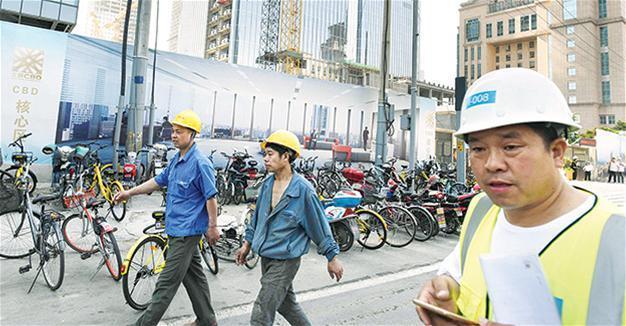China’s reforms not enough to arrest mounting debt: Moody’s
BEIJING - Reuters
 China’s structural reforms will slow the pace of its debt build-up but will not be enough to arrest it, and another credit rating cut for the country is possible down the road unless it gets its ballooning credit in check, officials at Moody’s said.
China’s structural reforms will slow the pace of its debt build-up but will not be enough to arrest it, and another credit rating cut for the country is possible down the road unless it gets its ballooning credit in check, officials at Moody’s said.The comments came two days after Moody’s downgraded China’s sovereign ratings by one notch to A1, saying it expects the financial strength of the world’s second-largest economy to erode in coming years as growth slows and debt continues to mount.
In announcing the downgrade, Moody’s Investors Service also changed its outlook on China from “negative” to “stable,” suggesting no further ratings changes for some time.
China has strongly criticized the downgrade, asserting it was based on “inappropriate methodology”, exaggerating difficulties facing the economy and underestimating the government’s reform efforts.
In response, senior Moody’s official Marie Diron said on May 26 that the ratings agency has been encouraged by the “vast reform agenda” undertaken by the Chinese authorities to contain risks from the rapid rise in debt.
However, while Moody’s believes the reforms may slow the pace at which debt is rising, they will not be enough to arrest the trend and levels will not drop dramatically, Diron said.
Diron said China’s economic recovery since late last year was mainly thanks to policy stimulus, and expects Beijing will continue to rely on pump-priming to meet its official economic growth targets, adding to the debt overhang.
Waiting for implementation
Moody’s also is waiting to see how some of the announced measures, such as reining in local government finances, are actually implemented, Diron, associate managing director of Moody’s Sovereign Risk Group, told reporters in a webcast.
China may no longer get an A1 rating if there are signs that debt is growing at a pace that exceeds Moody’s expectations, Li Xiujun, vice president of credit strategy and standards at the ratings agency, said in the same webcast “If in the future China’s structural reforms can prevent its leverage from rising more effectively without increasing risks in the banking and shadow banking sector, then it will have a positive impact on China’s rating,” Li said.
But Li added: “If there are signs that China’s debt will keep rising and the rate of growth is beyond our expectations, leading to serious capital misallocation, then it will continue to weigh on economic growth in the medium term and impact the sovereign rating negatively.”
“China may no longer suit the requirement of A1 rating.”
Li did not give a specific target for debt levels nor a timeframe for further assessments.
Moody’s expects China’s growth to slow to around 5 percent in coming years, from 6.7 percent last year, compounding the difficulty of reducing debt. But Diron said the economy will remain robust, and the likelihood of a hard landing is slim.
After Moody’s downgrade, its rating for China is on the same level as that on Fitch Ratings, with Standard Poor’s still one notch above, with a negative outlook.
On May 26, Fitch said it is maintaining its A+ rating. Andrew Fennel, its direct of sovereign ratings, noted China’s “strong macroeconomic track record”, but said that its growth “has been accompanied by a build-up of imbalances and vulnerabilities that poses risks to its basic economic and financial stability.”
Stimulus spree
Government-led stimulus has been a major driver of China’s economic growth over recent years, but has also been accompanied by runaway credit growth that has created a mountain of debt - now at nearly 300 percent of gross domestic product (GDP).
Some analysts are more worried about the speed at which the debt has accumulated than its absolute level, noting much of the debt and the banking system is controlled by the central government.
UBS estimates that government debt, including explicit and quasi-government debt, rose to 68 percent of GDP in 2016 from 62 percent in 2015, while corporate debt climbed to 164 percent of GDP in 2016 from 153 percent the previous year.
A growing number of economists believe that a massive bank bailout may be inevitable in China as bad loans mount. Last September, the Bank for International Settlements (BIS) warned that excessive credit growth in China signaled an increasing risk of a banking crisis within three years.
The Moody’s downgrade was seen as largely symbolic because China has relatively little foreign debt and local markets are influenced more by domestic factors, with many companies enjoying stronger credit ratings from home-grown agencies than they would in the West.
Still, the rating demotion highlighted investor worries over whether China has the will and ability to contain rising risks stemming from years of credit-fuelled stimulus, without triggering financial shocks or dampening economic growth.
China has vowed to lower debt levels by rolling out measures such as debt-to-equity swaps, reforming state-owned enterprises (SOEs) and reducing excess industrial capacity.
In recent months, regulators have issued a flurry of measures to clamp down on the shadow banking sector while the central bank has gingerly raised short-term interest rates.
But moves so far have been cautious, especially heading into a key political leadership reshuffle later this year.
The autumn’s Communist Party Congress is President Xi Jinping’s most important event of the year, where a new generation of up and coming leaders will be ushered into the Standing Committee, China’s elite ruling inner core.
But party congresses are always tricky affairs, as different power bases compete for influence, so the government will be keen to ensure there are no distractions like financial or economic problems or diplomatic confrontations.
















